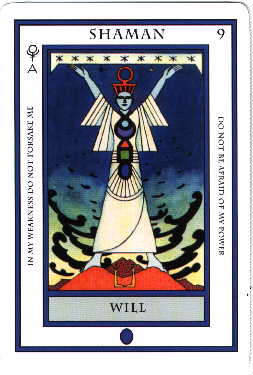
To many, the word “hermit” has a faintly antiquarian ring to it, so many moderns prefer “solitary” because life in the contemporary world makes the physical existence of being a classic hermit difficult. But even the classic hermit, in his or her simplicity, can represent an archetype, as in the Tarot.
Even those who reject the validity or efficacy of the Tarot can acknowledge the psychological component and the spiritual power of the archetype, and I don’t hesitate to recommend these latter concepts to adherents of any particular religious or spiritual tradition.
But it is easy to slip into extending the archetype too enthusiastically. For example, the hermit is not automatically a shaman, though every shaman identified by anthropology is a hermit at some necessary stage. Some Tarot practitioners identify the Hermit (9) as a Shaman (see inset image from a modern card set). That equates the hermit with a magician, mage, sorcerer, wizard, or conjurer — altogether different archetypes. It is a serious misinterpretation. Even a hermit in the classic archetype of searcher for truth, a kind of Diogenes mixed with images of desert, medieval, and Asian eremetical models, has no power that he claims, desires, seeks, or wants. Extrapolations from myth and literature notwithstanding, the classic hermit may want truth, and may project wisdom, insight, and harmony with the universe, but the hermit renounces power as soon as its scent reveals itself.
